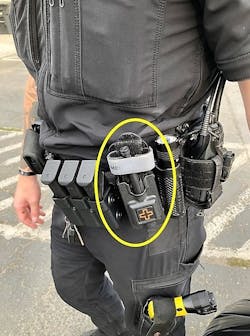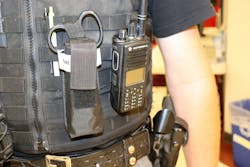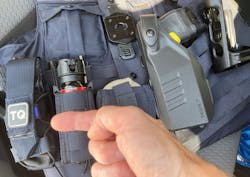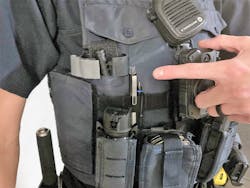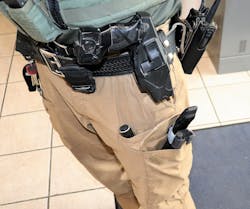All first responders are brothers and sisters. It doesn’t matter if you are a law enforcement officer, an EMT or a firefighter, we are all brothers and sisters. As brothers and sisters, we have the unwritten rule of looking out for each other.
As firefighters, are we really prepared to help our brother and sister law enforcement officers (LEO) should they become wounded at an active shooter incident?
It seems like hardly a day goes by that the media does not report on a shooting incident somewhere in the United States. In many of these instances, LEO rush into the area in which the gunshots are coming from, placing themselves at great personal risk.
As tools and techniques continue to improve, it is now very common to see LEO wearing tactical vests. On these vests can be found several pouches and pockets for carrying items like a tourniquet. However, some agencies have yet to secure the funding to purchase tactical vests and the LEO is forced to carry their tourniquet – if they even carry one - on their equipment belt. As it relates to tourniquets, some LEOs are carrying two tourniquets – one to use on themselves and one to use on you.
As part of their training, LEO now practice applying tourniquets. In some agencies, this practice can occur quite frequently. But have they ever worked with other first responders in practicing how to apply a tourniquet?
There are a few questions that firefighters and paramedics need to ask their brother and sisters in law enforcement regarding tourniquets.
Where do you carry your tourniquet?
During the recent conflicts involving the U.S. military, it was not uncommon for a wounded soldier to “bleed-out” before a tourniquet could be applied. This delay in applying the tourniquet was not because fellow soldiers did not know how to apply a tourniquet, but was the result of the fellow soldiers spending time looking for the materials to be used as a tourniquet.As a result of these lessons learned in combat, many LEOs now carry tourniquets.
In an active shooter incident, should an LEO become wounded, and the situation calls for the application of a tourniquet, the tourniquet of the wounded officer would be used, reserving the use of the treating LEO’s tourniquet for themselves should they become wounded. This emphasizes the point of having other first responders familiar in the locations that LEO carry their tourniquets.
It's common for LEO to carry their personal tourniquet in a location on their equipment belt or tactical vest of their choosing. If the LEO does not have a tactical vest, the tourniquet may be carried on their equipment (“tool”) belt near the LEO’s weapon, in some cases, forward of the weapon. If the LEO is wearing a tactical vest, the tourniquet may be found along the center line of the officer’s torso in a location that is visible and easily accessed. Tourniquets can even be found in the pockets of tactical pants.
Most agencies don’t have a policy in place that standardizes the placement of the tourniquet on the LEO’s belt or tactical vest. Instead, these agencies leave the location of the tourniquet up to the preference of the LEO. This can result in a delay of the application of the tourniquet as the first-aid provider searches the wounded LEO for their tourniquet. Depending upon the location, severity, etc. of the wound, a delay in the application of the tourniquet could prove to be fatal!Some law enforcement agencies are now requiring their officers to carry their tourniquet in a specified location as part of their agency’s policy, such as near the centerline of their chest in a visible location on their tactical vest. This enhances the LEOs ability to apply a tourniquet more quickly in a life-or-death situation.
Firefighters should reach out to their local LEOs to determine where the LEOs carry their tourniquet and if all personnel in the agency carry their tourniquets in the same location.
In speaking with an LEO recently, the author was informed that in addition to the tourniquet carried on their tactical vest, a tourniquet is also carried in the first-aid kit that is mounted on the rear of the head rest in each of their agency’s patrol vehicles. This is information that should also be shared with firefighters.What about the “neighbors?”
In many active shooter incidents, LEO from multiple agencies can respond. This could include local police, county sheriff, state police and even federal LEO. When determining where LEO carry their tourniquets, we must also consider where the LEO from neighboring agencies carry their tourniquet. Is this information that is shared with neighboring agencies including fire and EMS?
As an example, in a rural area in the Pacific Northwest, LEOs from the local police department, county sheriff’s office, state police, game warden, U.S. Forest Service and U.S. Bureau of Land Management law enforcement as well as LEO from agencies with a response time of well over an hour could respond to the incident. Do all of these LEO carry tourniquets and if so, where do they carry the tourniquet?Can you apply a tourniquet?
At first glance, this may appear to be a somewhat silly question. If we are Emergency Medical Technicians (EMT), we should be familiar with how to apply a tourniquet. Here are a couple of questions that we can ask our local LEOs as well as any firefighter and EMTs within our department who also serve as tactical medics:
Can you effectively apply a tourniquet to yourself? When was the last time that you practiced applying a tourniquet? We may feel that we can effectively apply a tourniquet, at least in a training situation, but what about a real active shooter incident?Can you effectively apply a tourniquet to your strong arm using your weak hand? Remember, time is of the essence when applying a tourniquet. It may be possible that first responders practice applying their tourniquet on a regular basis. However, they may practice applying to the same location on their body whenever they practice.
Many first responders practice applying a tourniquet in a classroom. Can you apply a tourniquet while lying on the ground behind a protective barrier?
As first responders, we pride ourselves in being able to take care of our own. Does this apply to public safety officers outside of our agency as well? Perhaps it’s time to invite the local LEO over to the fire station for coffee and a discussion about tourniquets while everyone is seated around the kitchen table.Thank you to North American Rescue for contributing the training tourniquet used in the photos.
About the Author

Jeff Riechmann
Jeff Riechmann is retired from the Kern County, CA, Fire Department, where he served as a firefighter for 23 years. Riechmann also retired from the U.S. Air Force Reserve as a deputy fire chief. He has taught fire technology and fire science at the college level. Riechmann can be reached at [email protected].

